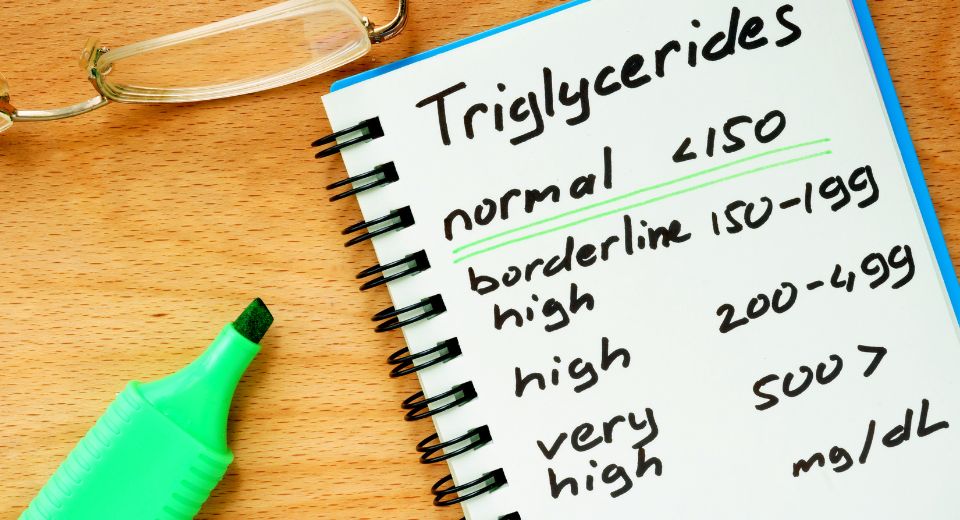Triglycerides are a type of lipid, or fat, found in your blood. When you consume more calories than your body needs for energy, it converts the excess into triglycerides, which are stored in fat cells. Later, when your body needs energy between meals, hormones release triglycerides for energy, effectively fueling your activities. Triglycerides are essential for normal body function. They provide energy, enable the absorption of certain vitamins, and insulate your body to maintain warmth. However, consistently high levels of triglycerides in the blood can lead to health problems, particularly concerning cardiovascular health.
A lipid profile or lipid panel is a panel of blood tests that serves as an initial broad medical screening tool for abnormalities in lipids, such as cholesterol and triglycerides. A lipid panel will also obtain information for HDL (high-density lipoprotein), which is the good cholesterol and LDL (low-density lipoprotein), the bad cholesterol.
Typical triglyceride measurements are:
- Normal – Less than 150 mg/dL
- Borderline – 150-199 mg/dL
- High – 200-499 mg/dL
- Very High – 500mg/dL and up
Like high cholesterol, high triglyceride levels can lead to clogged arteries and possibly a heart attack or stroke. Fortunately, lowering levels of high triglycerides are manageable:
- Take notice of what you are consuming: It’s difficult to balance a life that’s moving fast. Career, family, and stress can lead you to unnecessary snacking and unhealthy meals, but if there is no time to prepare a salad, then what other options are there, aside from fast food? If you have high triglycerides, then it is absolutely vital you get your sweet tooth in check. Simple sugars, especially fructose (a sugar often found in fruit), increase triglyceride levels, along with foods made with added sugars, including soda, baked goodies, candy, ice cream, most breakfast cereals, and flavored yogurt. It is best to avoid these food, or at the very least consume them in moderation.
- Eat the right kinds of fat: Being aware of calories is great, but also taking note of the types of fat you are consuming is just as important. Steer clear of trans fat, which is found in many processed foods, such as fries, chips, and margarine. The intake of saturated fats, like those found in red meats, cheeses, ice cream, and baked goods should be limited. A little fat is good for you — when it’s the healthy kind. Choose foods that naturally contain monounsaturated fat and polyunsaturated fat, like avocados, walnuts, and skinless chicken. Replace regular cooking oils with canola oil or extra virgin olive oil.
- Eat more nuts, greens, and fish: Switch from a snack of chips and crackers to raw almonds and walnuts. Nuts are packed with protein and Omega-3 fatty acids, which are good for your heart, and provide stamina throughout the day. More importantly, Omega-3 may also help lower your triglycerides. Try to eat fish at least twice a week. Wild salmon, mackerel, albacore tuna, and sardines are all high in Omega-3s. Additionally, other good sources of fatty acids can be found in salad greens, such as spinach, kale, and brussels sprouts. Incorporating at least two servings of salad greens per day to your daily diet will power up your meals with vitamins and proteins.
- Cut back on alcohol and sugary drinks: Excessive consumption of alcohol and drinks high in sugar can lead to higher triglyceride levels. Sodas and other sweetened drinks are compounded with fructose syrup — a turbo booster for high triglycerides. An occasional glass of red wine or a beer is fine, but one of the best ways to lower your triglycerides is to cut out alcoholic and sweetened drinks all together. There are other alternatives such adding club soda or sparkling water to natural fruit juices to liven up any drink and serve as a healthier alternative to sweetened drinks. It is okay to indulge every once in a while, just remember to sip slowly, enjoy the drink, and try not to overdo it.
- Lose weight if necessary: Although challenging, losing weight is attainable and is certainly the most important factor in lowering triglyceride levels. Extra weight buildup, particularly around your waist, raises triglycerides. The most effective way to lower triglycerides is to shed some of those extra inches by maintaining a regular workout regimen for 30 minutes a day and 5 days per week. Losing a mere 7 – 15 pounds will dramatically lower your triglyceride levels. Build up a sweat and keep your heart pumping with dance classes (like Zumba), swimming, or walking.
Triglycerides are an important component of your body’s energy metabolism, but elevated levels can increase the risk of cardiovascular disease. By adopting a healthy lifestyle that includes a balanced diet, regular exercise, weight management, and, if necessary, medication, you can effectively manage triglyceride levels and promote a healthier heart. Consult with your healthcare provider for personalized guidance on maintaining optimal triglyceride levels and reducing your risk of heart disease.
Author: Sarah Chan, PA-C
The information provided is for general interest only and should not be misconstrued as a diagnosis, prognosis or treatment recommendation. This information does not in any way constitute the practice of medicine, or any other health care profession. Readers are directed to consult their health care provider regarding their specific health situation.



